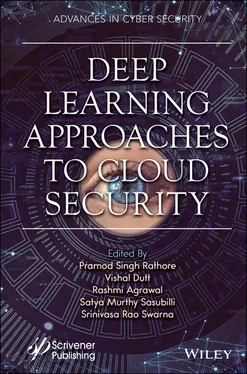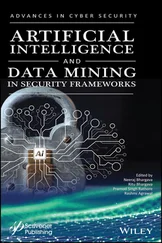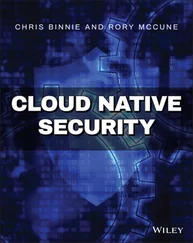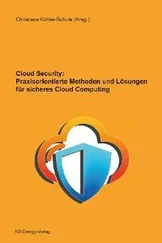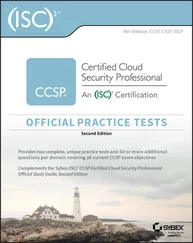Deep Learning Approaches to Cloud Security
Здесь есть возможность читать онлайн «Deep Learning Approaches to Cloud Security» — ознакомительный отрывок электронной книги совершенно бесплатно, а после прочтения отрывка купить полную версию. В некоторых случаях можно слушать аудио, скачать через торрент в формате fb2 и присутствует краткое содержание. Жанр: unrecognised, на английском языке. Описание произведения, (предисловие) а так же отзывы посетителей доступны на портале библиотеки ЛибКат.
- Название:Deep Learning Approaches to Cloud Security
- Автор:
- Жанр:
- Год:неизвестен
- ISBN:нет данных
- Рейтинг книги:3 / 5. Голосов: 1
-
Избранное:Добавить в избранное
- Отзывы:
-
Ваша оценка:
- 60
- 1
- 2
- 3
- 4
- 5
Deep Learning Approaches to Cloud Security: краткое содержание, описание и аннотация
Предлагаем к чтению аннотацию, описание, краткое содержание или предисловие (зависит от того, что написал сам автор книги «Deep Learning Approaches to Cloud Security»). Если вы не нашли необходимую информацию о книге — напишите в комментариях, мы постараемся отыскать её.
Covering one of the most important subjects to our society today, cloud security, this editorial team delves into solutions taken from evolving deep learning approaches, solutions allowing computers to learn from experience and understand the world in terms of a hierarchy of concepts, with each concept defined through its relation to simpler concepts.
Deep Learning Approaches to Cloud Security: Audience:
Deep Learning Approaches to Cloud Security — читать онлайн ознакомительный отрывок
Ниже представлен текст книги, разбитый по страницам. Система сохранения места последней прочитанной страницы, позволяет с удобством читать онлайн бесплатно книгу «Deep Learning Approaches to Cloud Security», без необходимости каждый раз заново искать на чём Вы остановились. Поставьте закладку, и сможете в любой момент перейти на страницу, на которой закончили чтение.
Интервал:
Закладка:
While the publisher and authors have used their best efforts in preparing this work, they make no representations or warranties with respect to the accuracy or completeness of the contents of this work and specifically disclaim all warranties, including without limitation any implied warranties of merchant-ability or fitness for a particular purpose. No warranty may be created or extended by sales representatives, written sales materials, or promotional statements for this work. The fact that an organization, website, or product is referred to in this work as a citation and/or potential source of further information does not mean that the publisher and authors endorse the information or services the organization, website, or product may provide or recommendations it may make. This work is sold with the understanding that the publisher is not engaged in rendering professional services. The advice and strategies contained herein may not be suitable for your situation. You should consult with a specialist where appropriate. Neither the publisher nor authors shall be liable for any loss of profit or any other commercial damages, including but not limited to special, incidental, consequential, or other damages. Further, readers should be aware that websites listed in this work may have changed or disappeared between when this work was written and when it is read.
Library of Congress Cataloging-in-Publication Data
ISBN 9781119760528
Cover image: Stockvault.com
Cover design by Russell Richardson
Set in size of 11pt and Minion Pro by Manila Typesetting Company, Makati, Philippines
Printed in the USA
10 9 8 7 6 5 4 3 2 1
Foreword
This is Dr. Abhishek Kumar, Assistant Professor in Chitkara University, Himachal Pradesh. I have been involved in the research for more than 8 years with the authors of this book. This book is about a solution to these more intuitive problems. This solution is to allow computers to learn from experience and understand the world in terms of a hierarchy of concepts, with each concept defined through its relation to simpler concepts.
This book is about how Deep Learning is the fastest growing field in computer science. Deep Learning algorithms and techniques are found to be useful in different areas like Automatic Machine Translation, Automatic Handwriting Generation, Visual Recognition, Fraud Detection, Detecting Developmental Delay in Children. However, applying Deep Learning techniques or algorithms successfully in these areas needs a concerted effort, fostering integrative research between experts ranging from diverse disciplines from data science to visualization. This book provides state of the art approaches of Deep Learning in these areas. It includes areas of detection, prediction, as well as future framework development, building service systems and analytical aspects. In all these topics, approaches of Deep Learning such as artificial neural networks, fuzzy logic, genetic algorithm and hybrid mechanisms are used. This book is intended for dealing with modeling and performance prediction of the efficient cloud security systems thereby bringing newer dimension.
This book shall help clarify understanding of certain key mechanism of technology helpful in realizing such system. Enables processing of very large dataset help with precise and comprehensive forecast of risk and delivers recommended action that improve outcome for consumer. It is a novel application domain of deep learning that is of prime importance to human civilization as a whole. This would be helpful for both professionals and students, with state-of-the art knowledge on the frontiers in information assurance. This book is a good step in that direction.
Dr. Abhishek Kumar
Assistant Professor
Abhishek Kumar || Assistant Professor, PhD, Senior Member (IEEE)
Chitkara University Research and Innovation Network (CURIN) Chitkara University, India
Preface
This book is organized into fifteen chapters. Chapter 1discusses the prevailing Biometric modalities, classification, and their working. It goes on to discuss the various approaches used for Facial Biometric Identification such as feature selection, extraction, face marking, and the nearest neighbor approach.
In Chapter 2we understand the cloud computing concept with Multi-Tenant Framework (MWF). In Multi-Tenant Framework, there is a requirement of privacy and security, a concept developed using Deep Learning. The goal is to find privacy requirements in many factors. Multi-tenancy based systems use the Deep Learning concept. The services of Multi-Tenant based systems are aggregated due to the dynamic environment of cloud computing. Three consistencies will maintain privacy policies using deep learning.
In Chapter 3, Automatic Emotion Detection using facial expression recognition is now a main area of focus in various fields such as computer science, medicine, and psychology. Various feature extraction techniques have been developed for classification of expressions from EEG signals from brain and facial expressions from static images, as well as real time videos. Deep Learning plays an important role for this kind of task. This chapter provides a review of research work carried out in the field of facial expression recognition and EEG Signal classification.
In Chapter 4, the main motivation of the proposed work is to improve the efficiency of wind power generation with the use of solar panels and utilize the power generated by solar cells effectively by powering the electrical components used inside the wind mill, such as revolving motor, elevators, etc. In this paper, various literatures have been reviewed and the remarkable features of the proposed system are highlighted. At the end, the data analysis is done using deep learning and all the results are visualized in graphical form. In the analysis, the power generation from our proposed system and traditional methods is visualized.
Chapter 5discusses mosaicing; a method of assembling multiple overlapping images of the same scene into a larger, wider image of a scene which overcomes the above issues. In the real-time monitoring, a major problem is that the field of vision is completely too small to capture the target and a larger field of vision results in low resolution. Ability to handle all the above issues, which includes management of quantity and quality feature extraction, is proposed. In this paper, Speeded Up Robust Features (SURF) are used to construct a mosaiced background model for foreground segmentation through deep learning.
In Chapter 6, Chronic Kidney Disease shows slow and periodical loss of kidney function over a period of time and will develop into permanent kidney failure when left untreated. The proposed work aims at presenting the use of Deep Learning for the prediction of Chronic Kidney Disease. Training has been performed using 16 attributes of about 400 patients. Three Deep Learning techniques like Random Forest, Support Vector Machine, and the Naive Bayes Classifier are helpful in predicting the stages. A comparative analysis of these three classifiers is performed.
Chapter 7provides a cognizance into the implementation of a support vector machine algorithm of Deep Learning to diagnose neurological conditions. With advancement of emerging technologies, the means of diagnosing neurological conditions is substantially more complex than it used to be. Procedures and diagnostic tests are tools that help doctors to identify a neurological illness or other medical condition. Precise identification of neurological pathologies can be done by adhering to an autopsy after the person’s passing.
In Chapter 8we define what convolution is needed in neural networks and the application of pooling on different data sets. This chapter also addresses how to use a CNN and the kind of operations it applies on the data-set. In this chapter, CNN are applied on image assets for feature extraction and dimensionality reduction.
Читать дальшеИнтервал:
Закладка:
Похожие книги на «Deep Learning Approaches to Cloud Security»
Представляем Вашему вниманию похожие книги на «Deep Learning Approaches to Cloud Security» списком для выбора. Мы отобрали схожую по названию и смыслу литературу в надежде предоставить читателям больше вариантов отыскать новые, интересные, ещё непрочитанные произведения.
Обсуждение, отзывы о книге «Deep Learning Approaches to Cloud Security» и просто собственные мнения читателей. Оставьте ваши комментарии, напишите, что Вы думаете о произведении, его смысле или главных героях. Укажите что конкретно понравилось, а что нет, и почему Вы так считаете.
